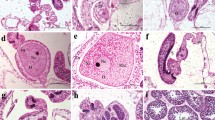Abstract
The effects of copper-enriched seawater on fertilization success, early cleavage, larval skeletal development, and survivorship of adults of the coral-reef echinoid Echinometra mathaei (de Blaiville) were tested. Fifty percent reduction of fertilization success and cleavage success to the 8-cell stage occurred in 0.18 and 0.42 mg added Cu++/l, respectively. Adults had respective 48- and 96-h TL50 values of 0.54 and 0.30 mg/l. Larval skeletal development was suppressed in 0.02 mg/l. The latter process appears to be very sensitive and may be the most suitable for assessing effects of stress on this species.
Similar content being viewed by others
Literature Cited
Calabrese, A., R.S. Collier, D.A. Nelson and J. R. MacInnes: The toxicity of heavy metals to embryos of the American oyster Crassostrea virginica. Mar. Biol. 18, 162–166 (1973)
Clark, A.M. and F.W.E. Rowe: Shallow-water Indo-West Pacific echinoderms, 238 pp. London: Trustees British Museum (Natural History) 1971
Jones, R.S. and R.H. Randall: A study of biological impact caused by natural and man-induced changes on a tropical reef. Tech. Rep. Univ. Guam 7, 1–184 (1973)
Kobayashi, N.: Fertilized sea urchin eggs as an indicating material for marine pollution bioassay, preliminary experiments. Publs Seto mar. biol. Lab. 18, 379–406 (1971)
Lewis, A.G., P.H. Whitfield and A. Ramnarine: Some particulate and soluble agents affecting the relationship between metal toxicity and survival in the calanoid copepod Euchaeta japonica. Mar. Biol. 17, 215–221 (1972)
Okazaki, K.: Skeleton formation of sea urchin larvae. II. Organic matrix of the spicule. Embryologia 5, 283–320 (1960)
Okubo, K. and T. Okubo: Study on the bio-assay method for the evaluation of water pollution. II. Use of fertilized eggs of sea urchins and bivalves. Bull. Tokai reg. Fish. Res. Lab. 32, 131–140 (1962)
Pearse, J.S.: Patterns of reproductive periodicities in four species of Indo-Pacific echinoderms. Proc. Indian Acad. Sci. 68, 247–279 (1968)
Thorson, G.: Length of pelagic life in marine invertebrates as related to larval transport by ocean currents. In: Oceanography, pp 454–474. Ed. by M. Sears. Washington, D.C.: American Association for the Advancement of Science 1961 (Publs Am. Ass. Advmt Sci. No. 67)
Waterman, A.J.: Effects of salts of heavy metals on development of the sea urchin Arbacia punctulata. Biol. Bull. mar. biol. Lab., Woods Hole 73, 401–420 (1937)
Wisely, B. and R.A.P. Blick: Mrotality of marine invertebrate larvae in mercury, copper, and zinc solutions. Aust. J. mar. Freshwat. Res. 18, 63–72 (1967)
Author information
Authors and Affiliations
Additional information
Communicated by J.S. Pearse, Santa Cruz
Contribution No. 68, University of Guam Marine Laboratory.
Rights and permissions
About this article
Cite this article
Heslinga, G.A. Effects of copper on the coral-reef echinoid Echinometra mathaei . Marine Biology 35, 155–160 (1976). https://doi.org/10.1007/BF00390937
Accepted:
Issue Date:
DOI: https://doi.org/10.1007/BF00390937




